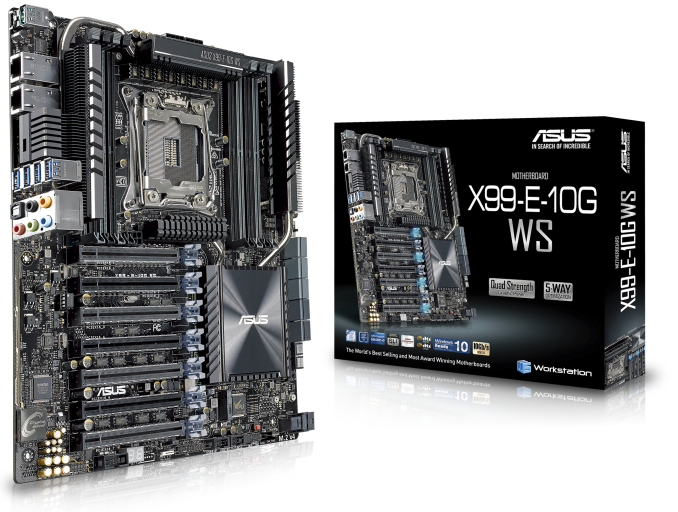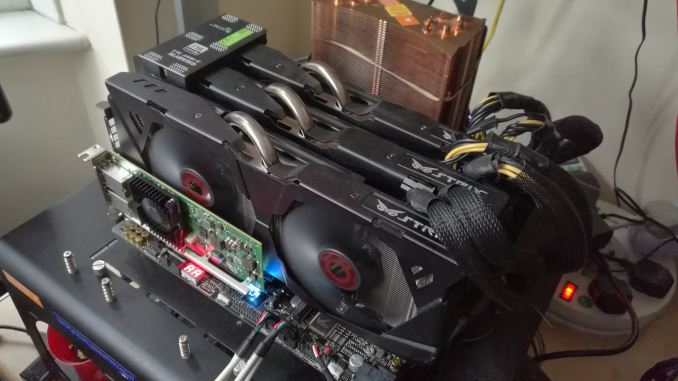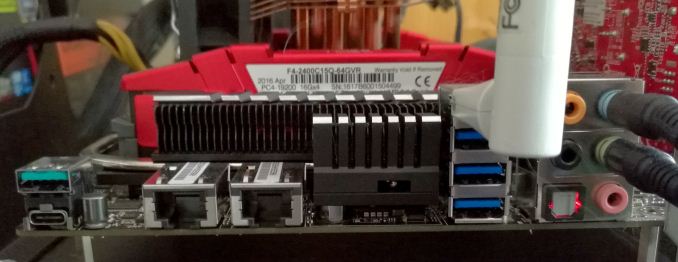The ASUS X99-E-10G WS Motherboard Review: 10GBase-T Networking with Intel’s X550-AT2
by Ian Cutress on November 7, 2016 9:00 AM EST- Posted in
- Motherboards
- Intel
- Asus
- 10G Ethernet
- X99
- 10GBase-T
- X99-E-10G WS
- X550
- X550-AT2
ASUS X99-E-10G WS Conclusion
As ASUS’ newest high-end desktop motherboard model, the X99-E-10G WS comes out with almost all guns blazing. It is hard to escape how much functionality is present, from a full complement of PCIe lanes (x16/x16/x16/x16) to dual 10G copper Ethernet ports to a full set of DRAM (and support for ECC Registered for Xeons) as well as PCIe storage for either M.2 or U.2 and USB 3.1 ports. Pretty much everything you need, except perhaps Thunderbolt 3, is here.
Ultimately this also pigeon holes the X99-E-10G WS into a highly specific market. Providing all this functionality isn’t cheap with the motherboard having to use two expensive Avago PCIe switches (PLX8747) and Intel’s newest PCIe 3.0 x4 X550-AT2 controller. This squares the motherboard down to users who needed 10G ports but were already lacking PCIe space. The numbers of users who qualify in that margin are set to be very low. Here’s an example of a use case: three GTX 980s with another 10G card (X540, PCIe 2.0 x8) attached in the bottom slot.
For performance, ASUS implements Multi-Core Turbo with the Core i7-5960X which gives our CPU benchmark results in the top half, but due to the PLX chip incurring a ~1% performance penalty, our gaming tests are the lowest we’ve seen for this set of tests on X99. For system benchmarks, the use of extra controllers does add to the POST time, but the audio performance is very good as well as USB 3.0/3.1 (with Turbo) and DPC Latency (one of ASUS’ recent strong points).
The BIOS and software side of the equation is ASUS’ usual consumer fare, and despite the X99-E-10G WS being a workstation focused board, aside from ECC Registered DRAM support with Xeons, there is nothing (nothing on the software side at least) that is specifically derived for workstations or prosumers that isn’t already on consumer platforms. That being said, fan controls, power and USB features are still relevant for most users.
The ASUS X99-E-10G WS does one thing really well – it offers the best single-socket option for integrated 10G support in the current market, and we will hopefully see more down the line (or at lower price points). As mentioned in our 10GBase-T motherboard overview earlier in the year, aside from the ASUS and ASRock boards available, and MSI’s C236 board with a single 10G port, options for integrated solutions are few and far between. Aside from switch pricing the ecosystem for home use, even as a prosumer play, needs to be driven by either switch availability (something like ASUS’ XG-U2008 at $250) or motherboard/PC adoption. So even at $600, the ASUS X99-E-10G WS shows how easy it can be to integrate 10G copper in the form of 10GBase-T.
Other Intel X99 Motherboard Reviews by AnandTech:
Prices Correct at time of each review
$750: The ASRock X99 WS-E 10G Review [link]
$600: The ASUS X99-E-10G WS Review (this review)
$600: The ASRock X99 Extreme11 Review [link]
$500: The ASUS Rampage V Extreme Review [link]
$400: The ASUS X99-Deluxe Review [link]
$340: The GIGABYTE X99-Gaming G1 WiFi Review [link]
$330: The ASRock X99 OC Formula Review [link]
$323: The ASRock X99 WS Review [link]
$310: The GIGABYTE X99-UD7 WiFi Review [link]
$310: The ASUS X99 Sabertooth Review [link]
$300: The GIGABYTE X99-SOC Champion Review [link]
$300: The ASRock X99E-ITX Review [link]
$300: The MSI X99S MPower Review [link]
$275: The ASUS X99-A Review [link]
$241: The MSI X99S SLI PLUS Review [link]













63 Comments
View All Comments
Notmyusualid - Friday, December 2, 2016 - link
TB3 IS great! - but not for the use case you describe, I think.r3loaded - Monday, November 7, 2016 - link
So why exactly IS 10G so expensive? Is there some inherent technical reason, or is it just Intel doing what Intel does best with a captive market over which they have a near monopoly?jhh - Monday, November 7, 2016 - link
Volume. There is a certain amount of engineering involved in making the NIC, and if you expect to sell 100,000, you recoup that engineering expense differently than if you expect to sell 10,000,000. I'm sure the volume is somewhere between those two targets. Volume will be limited if for no other reason that most devices connect via WiFi, and that until WiFi routers come with something other than a 1G port, it's hard to drive the market for 10G. The server environment is different, but fewer servers are sold than laptop/tablet/phone. No one is selling > 1G Internet to the residential market, so even that option isn't driving the market. One is then limited to people with the need to transfer at more than 1G speeds within a residence, and that market is small. Servers tend to use fiber, as the signal processing to support 10G over copper was historically adding significant latency compared to fiber. Fiber is also more forward compatible to 25G than copper, as every speed transition has always required different cables. Unless you are installing Cat 7a wire and proprietary connectors, but they aren't directly compatible with 1G wiring.Communism - Monday, November 7, 2016 - link
http://ark.intel.com/products/84329/Intel-Ethernet...The price per thousand is down to 80 USD for the controller (Which provides 2x 10G base-t ports), meaning one could theoretically integrate it into an x99 (or the boards coming out for Skylake-E/X) for around that much if you could get enough traction to be able to put them in a board with a significant portion of sales.
This sounds entirely feasible, unfortunately, they seem to be stuck on boards that are made purely for manufacturer advertising with hilarious prices like 700 USD.
Integrating such a controller is simple, as it's just a PCIe 3.0 x4 device.
Hopefully at least 1 of the major board manufacturers starts making reasonable integrations with the X550-AT2 controller in the Skylake-E/X generation boards.
bronan - Friday, November 11, 2016 - link
Intel sold their 10G cards for under 100 dollar each, when companies jumped onto them they slowly upped the prices to the max. These cards can be sold for under 50 dollar each but the hunger for huge profits will not allow thatBillR - Tuesday, November 8, 2016 - link
Terrific answer. 1G is everywhere and cost for those ports shows the power of huge volumes on prices. However, 10G is mostly limited to servers and there is a lot of competition for server connections (25G, 40G, 50G, 100G, Infiniband, etc.). Unfortunately fragmentation means higher prices.Ranger1065 - Monday, November 7, 2016 - link
zzzZZzzz.....bronan - Friday, November 11, 2016 - link
These chips cost really nothing for the gaints, the real prices of these chips are absolute below 10 dollar each. Again intel sold full fledged pci cards if i remember well around 77 dollar thats consumer price. See what happened after the companies started adopted them. I can't believe everbody makes it look like it so expenssive to make chips.... They cost them a few bucks to make thats it not 50 dollar+ my company makes chips for certain installations they costs 0.04 cents each and are sold to companies for 11 cents each ... talking about making profit. Thats the real prices you as consumer pay for that same 11 cents .... 10 dollar+ yes thats how the market works these days enormous profit is all what countsnirsever - Tuesday, November 8, 2016 - link
In fact, the footprint of the Tehuti Networks based solutions with PHYs from either Marvell or Aquantia are way smaller than the Intel X550 and since they don't require a heat sink, consuming ~5W max (for both MAC and PHY), they are much easier to integrate. The Tehuti Networks solutions are already supporting 2.5G and 5G in addition to standard 10GBase-T. You can find Tehuti Networks based 5-speed NIC cards already selling today for ~$200 while this figure is expected to drop significantly once new Marvell 802.3bz PHYs will start shipping in volumes early next yearnirsever - Tuesday, November 8, 2016 - link
Please take a look at what you can expect from Tehuti Networks and Marvell new PHY:http://www.tehutinetworks.net/?t=LV&L1=3&L...